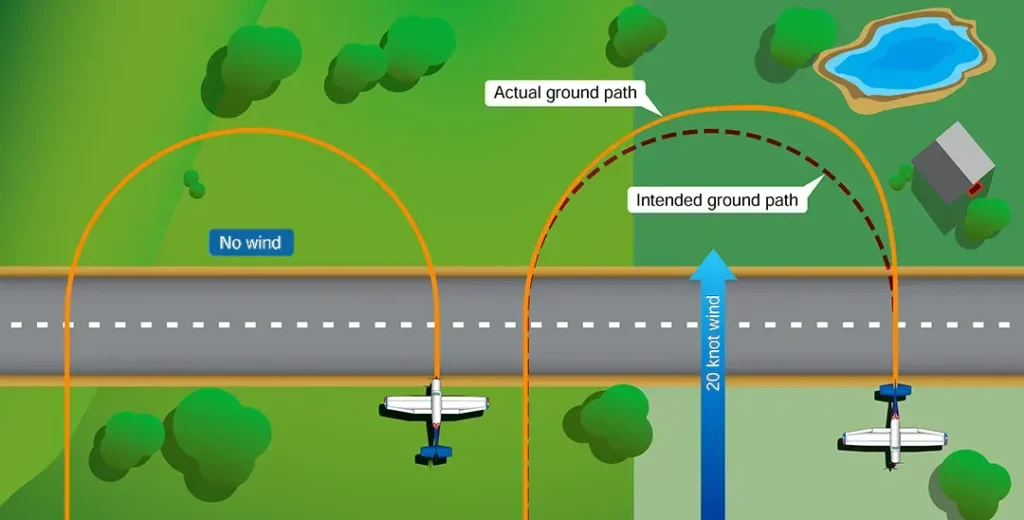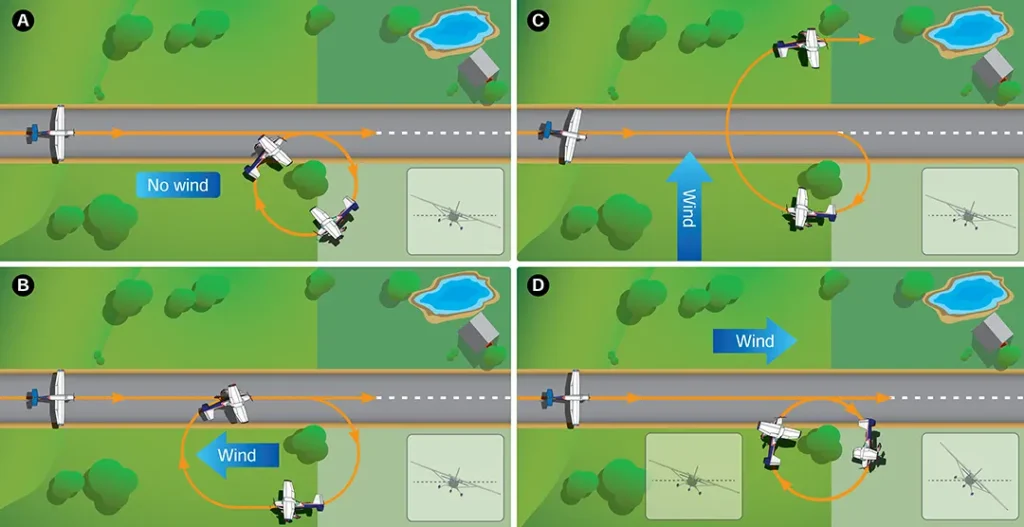Wind direction and velocity variations create the need for flightpath corrections during a ground reference maneuver. In a similar way that water currents affect the progress of a boat or ship, wind directly influences the path that the airplane travels in reference to the ground. Whenever the airplane is in flight, the movement of the air directly affects the actual ground track of the airplane.
For example, an airplane is traveling at 90 knots (90 nautical miles per hour) and the wind is blowing from right to left at 10 knots. The airplane continues forward at 90 knots but also travels left 10 nautical miles for every hour of flight time. If the airplane, in this example doubles its speed to 180 knots, it still drifts laterally to the left 10 nautical miles every hour. Unless in still air, traveling to a point on the surface requires compensation for the movement of the air mass.
Ground reference maneuvers are generally flown at altitudes between 600 and 1,000 feet above ground level (AGL). The pilot should consider the following when selecting the maneuvering altitude:
- The lower the maneuvering altitude, the faster the airplane appears to travel in relation to the ground.
- Drift should be easily recognizable from both sides of the airplane.
- The altitude should provide obstruction clearance of no less than 500 feet vertically above the obstruction and 2,000 feet horizontally.
- In the event of an engine failure, lower altitudes equate to less time to configure the airplane and reduced gliding distance before a forced landing.
- What specific altitude or altitude range does the testing standard call for?
Correcting Drift During Straight-and-Level Flight
When flying straight and level and following a selected straight-line direct ground track, the preferred method of correcting for wind drift is to angle the airplane sufficiently into the wind to cancel the effect of the sideways drift caused by the wind. The wind’s speed, the angle between the wind direction and the airplane’s longitudinal axis, and the airspeed of the airplane determine the required wind correction angle. For example, an airplane with an airspeed of 100 knots in an air mass moving at 20 knots directly from the side, should turn 12° into the wind to cancel the airplane’s drift. If the wind in the above example is only 10 knots, the wind correction angle required to cancel the drift is six degrees. When the drift has been neutralized by heading the airplane into the wind, the airplane will fly the direct straight ground track.
To further illustrate this point, if a boat is crossing a river and the river’s current is completely still, the boat could head directly to a point on the opposite shore on a straight course without any drift. However, rivers tend to have a downstream current that needs to be considered if the captain wants the boat to arrive at the opposite shore using a direct straight path. Any downstream current pushes the boat sideways and downstream at the speed of the current. To counteract this downstream movement, the boat needs to move upstream at the same speed as the river is moving the boat downstream. This is accomplished by angling the boat upstream to counteract the downstream flow. If done correctly, the boat follows a direct straight track across the river to the intended destination point. A slower forward speed of the boat or a faster river current requires a greater angle to counteract the drift. [Figure 1]

As soon as the pilot lifts off the surface and levels the wings in a crosswind, the airplane begins tracking sideways. The force of the crosswind acts on the mass of the airplane, and the speed of drift increases up to the speed of the crosswind component. A wind that is directly to the right or the left (at a 90° angle) will cause the airplane to accelerate sideways at the same speed as the wind. When the wind is halfway between the side and the nose of the airplane (at a 45° angle), it causes a sideways drift up to just over 70 percent of the total speed of the wind. It should be understood that pilots do not calculate the required drift correction angles for ground reference maneuvers; they merely use the references and adjust the airplane’s relationship to those references to cancel any drift. The groundspeed of the airplane is also affected by the wind. As the wind direction becomes parallel to the airplane’s longitudinal axis, the magnitude of the wind’s effect on the groundspeed is greater; as the wind becomes perpendicular to the longitudinal axis, the magnitude of the wind’s effect on the groundspeed is less. In general, When the wind is blowing straight into the nose of the airplane, the groundspeed will be less than the airspeed. When the wind is blowing from directly behind the airplane, the groundspeed will be faster than the airspeed. In other words, when the airplane is headed upwind, the groundspeed is decreased; when headed downwind, the groundspeed is increased.
Constant Radius During Turning Flight
In a no-wind condition, a pilot may make a constant-radius turn over the ground using a fixed bank angle. If wind is present, however, a pilot will observe a change in the radius of a turn while maintaining that same constant bank angle. [Figure 2] As groundspeed increases, the observed radius of the turn increases. Conversely, as groundspeed decreases, the radius of the turn over the ground will decrease. For a ground-referenced constant-radius turn, the pilot compensates for changes in groundspeed by varying the bank angle throughout the turn. When groundspeed increases, the pilot banks more steeply to maintain a constant-radius turn over the ground. The converse is also true: when groundspeed decreases, the pilot uses a shallower bank.

For a given true airspeed, the radius of turn in the air varies proportionally with the bank angle. To maintain a constant radius over the ground, the bank angle used is proportional to groundspeed. For example, an airplane is in the downwind position at 100 knots groundspeed. In this example, the wind is 10 knots, meaning that the airplane has an airspeed of 90 knots (for this discussion, assume true, calibrated, and indicated airspeed are all the same). If the pilot starts a turn using a 45° bank angle, the turn radius over the ground at that moment is approximately 890 feet. As the airplane turns, the groundspeed decreases and the bank angle needs to be reduced in order to maintain the same turn radius of 890 feet over the ground. At the upwind point of the turn, the bank angle should be approximately 33°. In another example, if the downwind is flown at an airspeed of 90 knots in a 10 knot tailwind with a desired turn radius of 2,000 feet, the bank angle would be approximately 24°. The bank angle flying upwind would be approximately 16°.
Put another way, at a higher groundspeed, there is less time to turn the airplane while trying to maintain a ground-referenced constant-radius turn. The pilot increases the bank angle in order to increase the rate of turn, and the increased rate of turn offsets the reduced time available to make the turn. Conversely, when flying at a lower groundspeed, the pilot reduces the angle of bank and rate of turn to compensate for the additional time taken while making the turn. With some experience, pilots may notice how wind direction affects the time needed for various segments of ground-referenced turns.
To demonstrate the effect that wind has on turns, the pilot should select a straight-line ground reference, such as a road or railroad track. [Figure 3] Choosing a straight-line ground reference that is parallel to the wind, the airplane would be flown into the wind and directly over the selected straight-line ground reference. Once a straight-line ground reference is established, the pilot makes a 360° constant medium-banked turn. As the airplane completes the 360° turn, it should return directly over the straight-line ground reference but downwind from the starting point. Choosing a straight-line ground reference that has a crosswind, and using the same 360° constant medium-banked turn, demonstrates how the airplane drifts away from the reference even as the pilot holds a constant bank angle. In both examples, the path over the ground is not circular, although in reference to the air, the airplane flew a perfect continuous radius.

In order to compensate for the effects of wind drift, the pilot adjusts the bank angle as the groundspeed changes throughout the turn. Where groundspeed is the fastest, such as when the airplane is headed downwind, the bank angle should be steepest. Where groundspeed is the slowest, such as when the airplane is headed upwind, the bank angle should be shallow. It is necessary to increase or decrease the angle of bank, which increases or decreases the rate of turn, to achieve the desired constant radius track over the ground.
Ground reference maneuvers should always be entered from a downwind position. This allows the pilot to establish the steepest bank angle required to maintain a constant radius ground track. If the bank is too steep, the pilot should immediately exit the maneuver and re-establish a lateral position that is further from the ground reference. The pilot should avoid bank angles in excess of 45°due to the increased stalling speed.
Tracking Over and Parallel to a Straight Line
The pilot should first be introduced to ground reference maneuvers by correcting for the effects of a crosswind over a straight-line ground reference, such as road or railroad tracks. If a straight road or railroad track is unavailable, the pilot should choose multiple references (three minimum) which line up along a straight path. The reference line should be suitably long so the pilot has sufficient time to understand the concepts of wind correction and practice the maneuver. Initially, the maneuver should be flown directly over the ground reference line with the pilot angling the airplane’s longitudinal axis into the wind sufficiently such as to cancel the effect of drift. The pilot should scan between far ahead and close to the airplane to practice tracking multiple references.
When proficiency has been demonstrated by flying directly over the ground reference line, the pilot should then practice flying a straight parallel path that is offset from the ground reference. The offset parallel path should not be more than three-fourths of a mile from the reference line. The maneuver should be flown offset from the ground references with the pilot angling the airplane’s longitudinal axis into the wind sufficiently to cancel the effect of drift while maintaining a parallel track.
